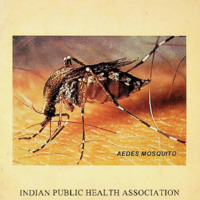DENGUE-PREVENTION AND CONTROL
Item
- Title
- DENGUE-PREVENTION AND CONTROL
- extracted text
-
DENGUE - PREVENTION AND CONTROL
INDIAN PUBLIC HEALTH ASSOCIATION
Courtesy:
CYANAMID
THE WORLD LEADER IN PUBLIC HEALTH PRODUCTS
WHAT IS DENGUE?
*
Dengue is a serious viral disease transmitted by the bite of the
mosquito, Aedes aegypti.
*
Dengue occurs in two forms : dengue fever and dengue
haemorrhagic fever.
*
Dengue fever is a severe, flu-like illness that affects older
children and adults but rarely causes death.
*
Dengue haemorrhagic fever (DHF) is a more severe form, in
which bleeding and occasionally shock occur, leading to death;
it is most serious in children.
*
Persons suspected of having dengue fever or DHF must see a
doctor at once. Dengue haemorrhagic fever is a deadly disease
and early diagnosis and treatment can save lives. Unless proper
treatment is given promptly, the patient may go into shock
and die. All Patients with fever and bleeding should be
hospitalised.
* The symptoms of dengue fever vary according to the age and
general health of the patient. Infants and young children may
have a fever with a measles-like rash, which is difficult to
distinguish from influenza, measles, malaria, viral hepatitis
and other diseases with fever. Children and adults may have
similar symptoms ranging from mild illness to very severe
disease.
/
WHY IS DENGUE IMPORTANT TO YOU?
Dengue fever and, in particular life-threatening DHF, often
occur in massive epidemics. Dengue spreads rapidly affecting
a great many people during an epidemic, most importantly
causing the loss of lives. Dengue, like the mosquito that carries
it, is found throughout tropical regions of the world. It is
reported from over 100 countries, with approximately 2000
million people at risk. It affects young and old, rich and poor
alike, especially those living in densely crowded urban areas
throughout the tropics.
SYMPTOMS OF DENGUE FEVER:
* Abrupt onset of high fever.
*
Severe frontal headache.
*
Pain behind the eyes which worsens with eye movement.
*
Muscle and joint pains.
*
Loss of sense of taste and appetite.
*
Measles-like rash over chest and upper limbs.
* Nausea and vomiting.
2
SYMPTOMS OF DENGUE HAEMORRHAGIC FEVER AND
SHOCK:
*
Symptoms similar to dengue fever.
*
Severe and continous stomach pains.
*
Pale, cold or clammy skin.
*
Bleeding from the nose, mouth and gums and skin bruising.
*
Frequent vomiting with or without blood.
*
Sleeping and restlessness.
*
Constant crying.
*
Excessive thirst (dry mouth)
*
Rapid weak pulse.
*
Difficulty in breathing.
TREATMENT OF DENGUE & DHF
Up to 20% of people with severe dengue or DHF may die if
not properly diagnosed and treated. However, with early
detection and proper case management, mortality can be
reduced substantially.
AVOID SELF MEDICATION : DO NOT TAKE ASPIRIN
3
AIEOES MCS'CUIW:------------
AIR COOLER
FLOWERPOT VASE
lERIEIEIEWED IEIREIEIEIIMG PLACES
HOW IS DENGUE SPREAD?
Dengue is spread by the bite of an infected female Aedes
aegypti mosquito which has got the dengue virus by taking a
blood meal from a person who was ill with dengue. The
infected mosquito then transmits the disease through its bite
to other people who in turn becomes ill, and the chain
continues.
WHERE DOES THE DENGUE MOSQUITO BREED?
Dengue mosquito breeds in any water-catching or storage
containers in shaded or sunny places. Favoured breeding places
are:
Desert-coolers, drums, jars, pots, buckets, flower vases, plant
saucers, tanks, cisterns, bottles, tins, tyres, roof gutters,
refrigerator drip pans, catch basins, drains, soak-away pits,
cement blocks, cemetery urns, bamboo stumps, tree cavities
and a lot more places where rain water collects or is stored.
HOW CAN DENGUE BE PREVENTED:
DO’S & DON'TS
The following control measures which are recommended by
WHO/NICD may be taken to prevent Dengue:
A. Elimination of mosquito breeding places:
* Do not allow water stagnations in coolers, discarded tyres,
containers, drums, flower pot vases, ornamental tanks in and
around the houses.
Ensure overhead water tanks are covered.
Empty all water collections/ containers, cisterns, storage tanks
once a week (Dry Day) in your house and locality through
Residents Welfare Associations.
6
B PC^o?d mosquito biles by use of Mosquito Nets & Repellents.
*
* Do not wear clothes that expose arms and legs.
Children should not be allowed to play in shorts and halt
*
sleeved clothes.
C. Larvicides:
Use of Larvicides like ABATE (Temephos) on a weekly basis
in all stagnant water collections in and around the houses to
prevent Mosquito breeding.
D. Adulticides:
Adulticidal treatments should be made at 7-10 days intervals
to kill active flying adult mosquitoes using Malathion
Technical.
E. Priority Areas for Vector Control:
Priority Areas for Vector Control are those with high mosquito
density or concentration of fever cases like hospitals, schools
industrial towns & townships, housing societies, etc.
7
WHY DENGUE EPIDEMICS ARE INCREASING?
*
Increasing urban populations
*
Expanding mosquito breeding due to:
- Unreliable water supply;
- Traditional water storage practices;
- Poor sanitation (create more mosquito breeding places);
- Changing lifestyles.
*
Rapid transportation
- Movement of infected humans;
- Spread of Aedes mosquitoes.
*
Inadequate community awareness about Dengue and its
prevention.
*
Lack of community participation in preventing mosquito
breeding.
*
Insufficient Mosquito Control Programmes.
INDIAN PUBLIC HEALTH ASSOCIATION
For further information contact:
National Institute of Communicable Diseases
22-Sham Nath Marg,
Delhi-110 054.
Courtesy: ^cyanamid
8
RADIUS PRINTOFAST NGW D61HI 91-11-3326966. 3354640
- Media
 6040.pdf
6040.pdf
Position: 3838 (2 views)
